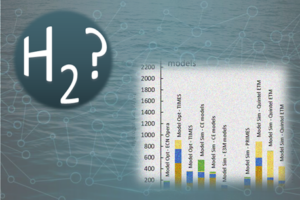Detz, R.J.
Publicaties van Detz, R.J.
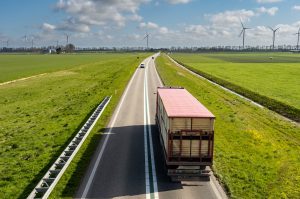
Hernieuwbare brandstoffen van niet-biologische oorsprong (RFNBO) voor transport
Renewable Fuels of Non-Biological Origin Hernieuwbare brandstoffen van niet-biologische oorsprong (Renewable Fuels of Non-Biological Origin – RFNBO) zijn vloeibare en gasvormige brandstoffen waarvan de energie-inhoud afkomstig is van hernieuwbare bronnen anders dan biomassa. Denk aan hernieuwbare waterstof geproduceerd door elektrolyse en brandstoffen geproduceerd uit hernieuwbare waterstof en koolstofdioxide of stikstof. Deze studie onderzoekt de mogelijkheden […]
Lees meer
Ontwikkeling kosten groene en blauwe waterstof
Productiekosten waterstof De kosten van centrale grootschalige productie van groene waterstof (hernieuwbare waterstof geproduceerd door middel van elektrolyse) komen voor 2025 uit op €4,4 – 6,5 per kilogram waterstof (€/kg H2) en kunnen mogelijk afnemen tot 3,6 – 5,8 €/kg H2 in 2030. Een combinatie van optimistische aannames (zoals een snelle daling van investeringskosten voor […]
Lees meer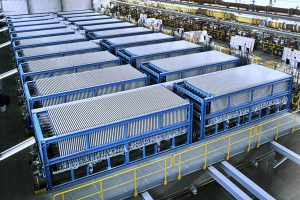
Wat kost een fabriek voor de productie van groene waterstof (in de toekomst)?
Elektrolyse-installaties voor de productie van groene waterstof.Bron: https://www.airproducts.com/news-center/2020/07/0705-air-products-and-thyssenkrupp-agreement-for-electrolysis-plants-to-generate-green-hydrogen Kennisontwikkeling en schaalvergroting Energie uit hernieuwbare energiebronnen kan door middel van elektrolyse van water worden vastgelegd in waterstof. Naast de kosten van hernieuwbare energie spelen de investeringskosten van de elektrolysefabriek een belangrijke rol bij de uiteindelijke productiekosten van waterstof. In dit onderzoek is door middel van een […]
Lees meer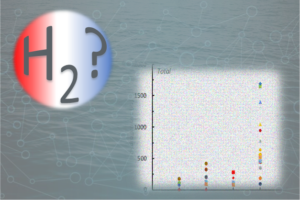
Hydrogen in the Netherlands. A review of recent Dutch scenario studies
We provide a review of the projected range in hydrogen use across various sectoral applications based on 13 studies reported in the recent literature (see Appendix A for a list of the studies). Studies with a focus on other regions, for instance on Europe or the world, are used in the discussion in a qualitative […]
Lees meer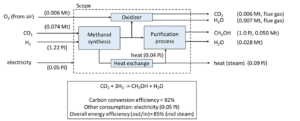
Methanol production from CO₂
The process runs at a typical temperature of 200-250 °C and at 30-80 bar. The conversion of CO2 in this direct methanol synthesis route is not so high (21%, Anicic, 2014; 33%, Van Dal, 2013), which allows for improvement in the future, e.g. by the development of new catalysts and technologies. After the reaction, the […]
Lees meer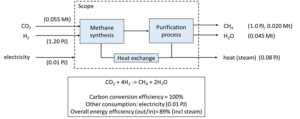
Methane production from CO₂
Both H2 and CO2 are provided in this case from external sources. CO2 methanation is a linear combination of CO methanation and reverse water–gas shift reaction and the equilibrium of both reactions is influenced by pressure (1-100 bar) and temperature (200-550 °C). Typically, a couple (2-7) of adiabatic fixed bed reactors are coupled in series […]
Lees meer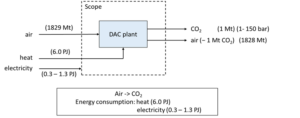
Direct Air Capture (DAC) of Carbon Dioxide
No large scale commercial plants exist today and pilot plants vary significantly in their process design. We here describe the plant very basically, without a strict technology design, and use average values for costs and energy use. We here assume that the produced CO2 is 100% pure, although in reality the product may contain traces […]
Lees meer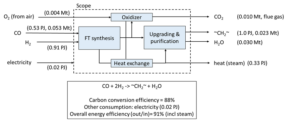
Fischer-Tropsch fuel production
The crude FT oil exists typically (e.g. Shell’s Middle Distillates Synthesis) out of long chain waxy molecules and is subsequently upgraded by a hydro-isomerisation and hydrocracking step (mild conditions of temperature and pressure) and distillation to produce the desired, lighter products. Although the mixture of produced hydrocarbons may vary depending on the process and conditions, […]
Lees meer
